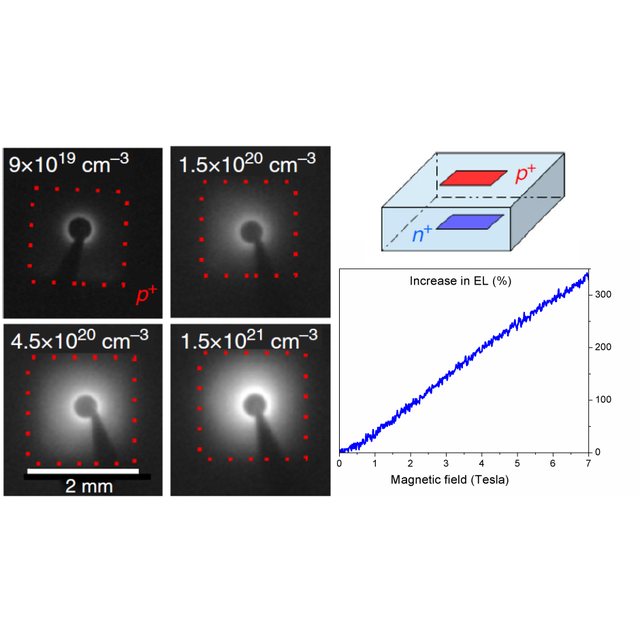Physicists from the Centre de Nanosciences et de Nanotechnologies, the Laboratoire de Physique des Solides, and the University of Cambridge have demonstrated efficient silicon light-emitting diodes using an original manufacturing method. The device is very simple and provides a luminescence at once strong and controllable by a magnetic field at room temperature.
Spin-dependent recombination, where only the singlet state of an electron-hole pair can recombine radiatively, can provide a precious insight on the role of spin in low spin-orbit coupling materials, such as organic semiconductors or silicon. However, in silicon, electron-hole pair recombination is highly improbable due to its indirect gap band structure. Despite the clear potential of silicon for applications, making an efficient light emitting diode (LED) with this material is a challenge, and generally requires a complex design and engineering.
Physicists from the Centre de Nanosciences et de Nanotechnologies/Centre for Nanoscience and Nanotechnology - C2N (CNRS / Paris-Sud University) and the Laboratoire de Physique des Solides - LPS (CNRS / Paris-Sud University), in collaboration with the Optoelectronics group of University of Cambridge, have taken up this challenge. Their work, published in the journal Nature Communications, shows the possibility of producing efficient silicon LED diodes thanks to an original fabrication method based on Gas Immersion Laser Doping (GILD).
A specificity of this technique is that the doping levels obtained are extreme, which intensifies the emission in the LEDs consisting of a junction between boron-doped silicon, intrinsic silicon and phosphorus-doped silicon (Si:B / Si / Si:P). In addition, laser doping allows to maintain a well-defined planar geometry, necessary to be able to align the magnetic and electrical fields in the LEDs and thus to overcome conventional magnetoresistance effects. By probing the spin-dependent recombination in these silicon LEDs, a spectacular increase in electroluminescence with the magnetic field has been demonstrated: 100% at room temperature and up to 300% at 150K. The proposed model describes this phenomenon by a spin-dependent radiative recombination of weakly bound electron-hole pairs. By this optoelectronic approach, it is thus possible to study the impact of the spin statistics on the luminescent emission of silicon, which appears to be a leading candidate for large-scale quantum spin electronics.
Figure : Diagram and infrared images of Si-LEDs polarized at I = 20mA at room temperature for different levels of doping. Magneto-EL at T=150 K and I=5 mA. © C2N / F. Chiodi
Reference
Room temperature magneto-optic effect in silicon light-emitting diodes
F. Chiodi, S.L. Bayliss, L. Barast, D. Débarre, H. Bouchiat, R.H. Friend et A.D. Chepelianskii
Nature Communications (January 2018)
DOI: https://www.nature.com/articles/s41467-017-02804-6
Contact
- Francesca Chiodi, Assistant Professor Paris-Sud University at C2N
Informations complémentaires
- Centre de Nanosciences et de Nanotechnologies – C2N (CNRS/Paris-Sud University)
- Laboratoire de Physique des solides – LPS (CNRS / Paris-Sud University)
- Cavendish Laboratory, University of Cambridge, UK









